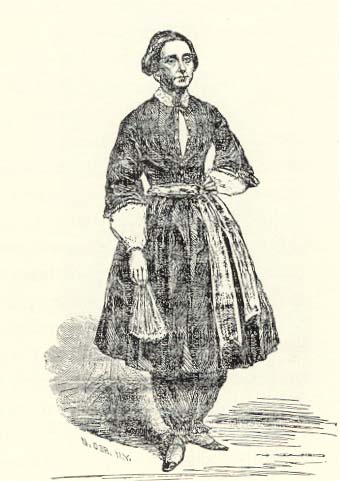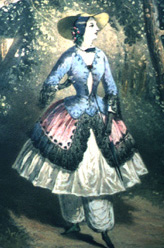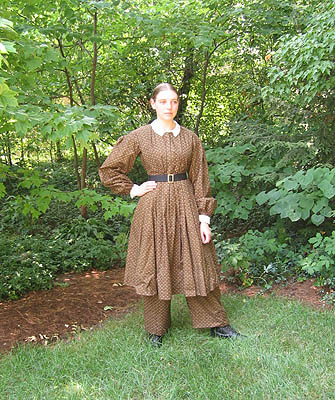19th Century Dress Reform In Pictures


(Courtesy of the Water-Cure Journal, October 1851)
"We should indeed be a free people. Freed from the petty tyranny which now rules us with a rod of iron, we should become strong and vigorous in body and mind, and independent and courageous in thought and action."
(Amelia Bloomer, in The Lily, June 1851)
During the Spring of 1851 a woman by the name of Elizabeth Smith Miller began experimenting with a new design of women's clothing she described as "Turkish trousers to the ankle, with a skirt reaching some four inches below the knee" to replace the swaddling long skirts she wore daily. The reformed style was undoubtedly more comfortable and liberating than her previous dresses that weighed her down with nearly 35 yards of fabric and over 10 pounds of petticoats at her waist. Along with the corset worn by women of the era, the conventional style of women's dress caused, "distorted spines, compressed lungs, enlarged livers, and displacement of the whole abdominal viscera . . . a weary soul in a weary frame" (The Lily, June 1851).
Soon after shortening her skirts and donning Turkish Trousers, Miller visited her cousin, Elizabeth Cady Stanton, in Seneca Falls, New York and introduced the reform dress to her. Stanton copied her cousin's designs, and the two women then decided to inform another friend, Amelia Jenks Bloomer, of their new style of dress. Bloomer, intrigued with the healthier form of clothing, adapted the style to her own tastes. As editor and publisher of The Lily, A Ladies Journal, Devoted to Temperance and Literature, Bloomer wrote an article in the next issue advocating the benefits of Miller's "Freedom Dress" or "Rational Dress."
It did not take long before the popular press and society began to take hold of this reform dress and rename it the "Bloomer Costume" or "Bloomers," after the woman who first publicized the style. Reform dress was soon viewed as a "ridiculous and indecent dress" fit only for women "of an abandoned class, or of those of vulgar women whose inordinate love of notoreity is apt to display itself in ways that induce their exclusion from respectable society" (International Monthly, November 1851). Society feared a Dress Reform Movement would cloud the social standards that governed feminine and masculine norms. Society was concerned that dress reform for women was only the beginning - that if the reform was successful, social distinctions would vastly change. Would male and female roles be reversed? Would men become subordinate and start wearing long skirts? In the minds of people today, such reactions may seem absurd, but during the mid-nineteenth century, the fears were all too real. This was an era in which social laws regarding women reflected statements such as: "It is an equivocal compliment to woman that man should treat her like a doll he is in constant fear of breaking" (J.D. Milne).
Despite the negative reactions held by society, the Dress Reform Movement spread and became associated with the struggle for women's emancipation. Elizabeth Cady Stanton argued that: "Woman will never hold her true position, until, by a firm muscle and a steady nerve, she can maintain the RIGHTS she claims . . . but she cannot make the first move . . . until she casts away her swaddling clothes" (The Sibyl, February 1857). Thus, in the eyes of several female dress reformers, a reform in women's dress was one of the first steps towards women's liberation.
The next few pages attempt to provide a variety of images seen in both the popular press and reality in regards to the ninteenth century Dress Reform Movement. It is also important to note that not every woman wore shortened skirts and trousers for the same reasons, and not all women wore the same style of reform dress. The variety is remarkable, and that is why I created this web site - to provide a link to the history and progress of the nineteenth century Dress Reform Movement. Because I focus almost exclusively on images throughout these pages, please check out my References and Links page for more historical documentation. Enjoy, and please feel free to email me at Bloomerite@hotmail.com with any comments or suggestions you may have.

Table of Contents
Possible Inspirations for the "Bloomer Costume"
Construction of the "Bloomer Costume"
The Original "Bloomer Girls"
Notable Quotations from Female Dress Reformers
Dress Reform in the Media
Similar Styles of Dress Throughout History
Today's "Bloomer Girls"
References And Links
About Me
Don't forget to sign my Guestbook!
You are visitor number to visit this site!
to visit this site!
Counter provided by www.Digits.com.

Britta Arendt, the Webmaster, dressed in one of her rational dresses
Copyright 2002 by Britta Arendt






